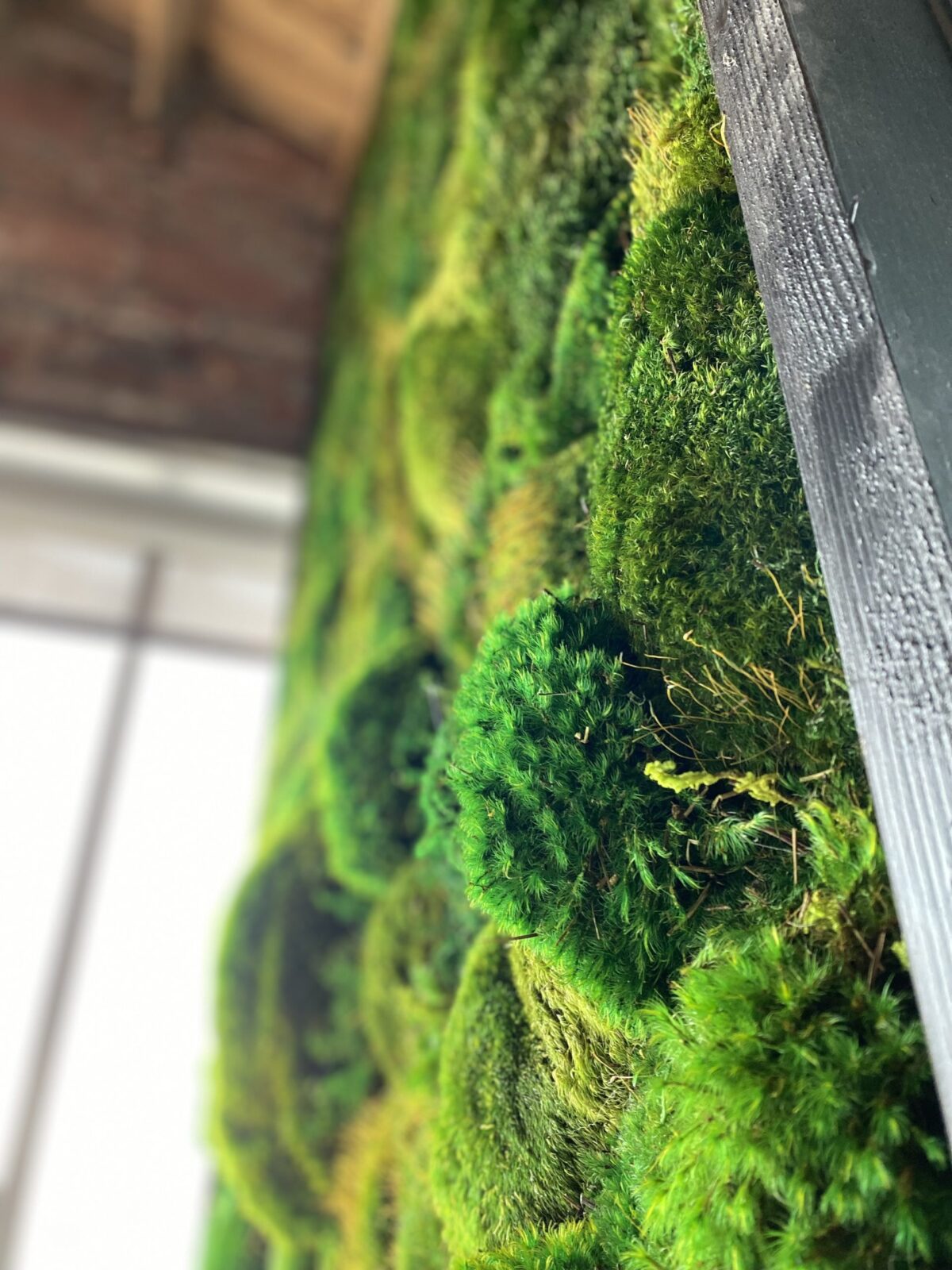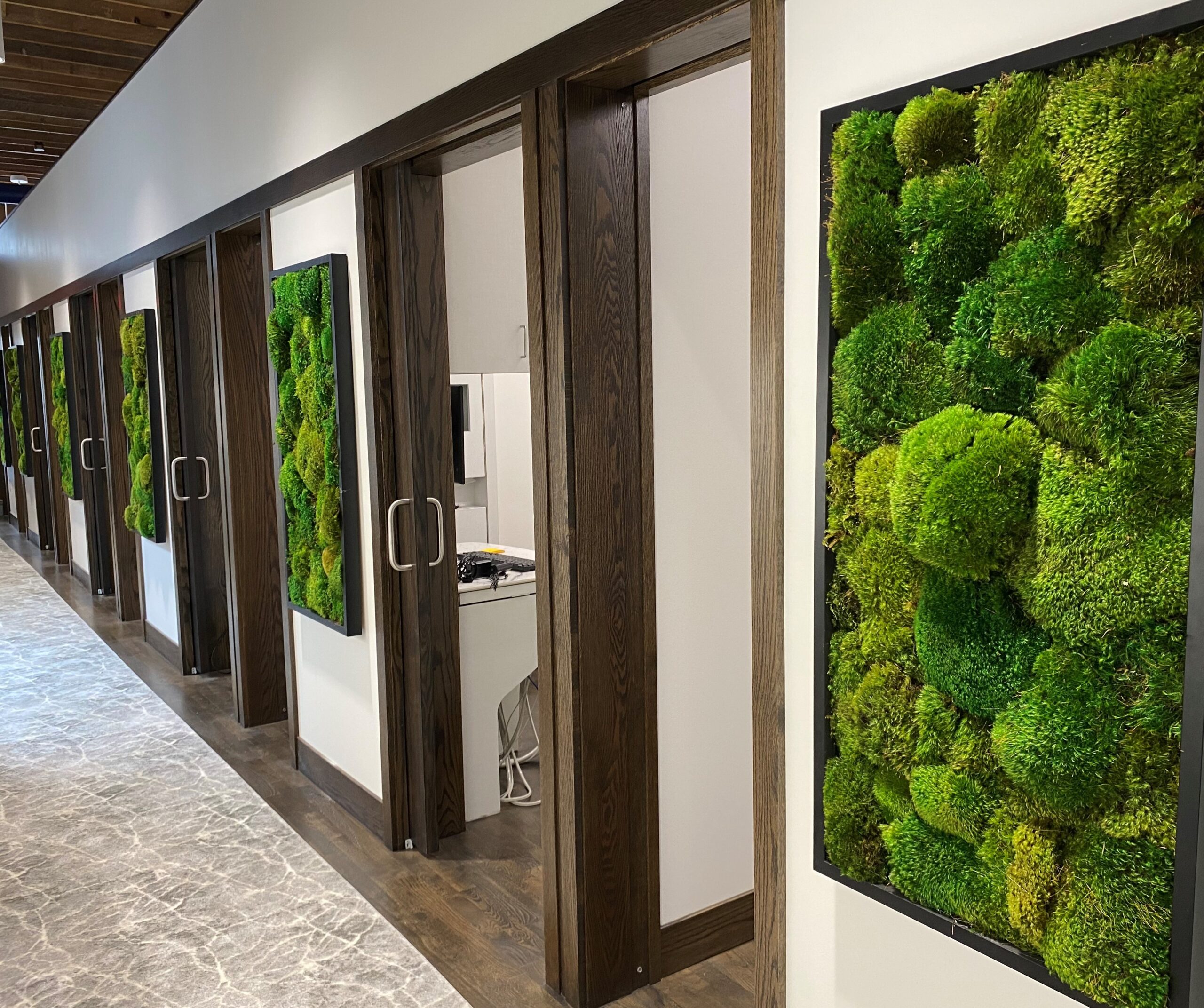
“Moss alley” at River Market Dental. Interior design by Josue Montes, 1DapperLatino.
There is more than one way to bring nature (as a biophilic design element) into your home or workplace so we’re going to break down the difference between moss walls and living plant walls and help you determine which is best for your needs and desires.
We will also give you the skinny on each of these brilliant biophilic design options that provide attention restoration and other wellness benefits including noise and air pollutant reduction.
The first “edition” of this article (a few years ago) addressed that green walls are appearing more and more frequently in the workplace, public spaces, and residential spaces, but a lot has changed in a few years and we are thrilled to share that biophilic design is now a design standard.
As Tim Nelson notes in an article for Architectural Digest titled, “The 6 Big Ideas Interior Designers Need to Know in 2023, According to ASID (American Society of Interior Designers)”:
“Though aesthetic choices remain important, there’s a greater need now more than ever to consider how an environment impacts the people who use a space.
In 2023, that will translate to an increased value on spaces designed to alleviate stress and promote an overall sense of wellness.
That’s especially true in the workplace, as employers still have to sell their employees on the value of physically showing up to the office.”
–Tim Nelson, for Architectural Digest
There are many ways to incorporate biophilic design concepts into your home, workspace or both and they all have benefits but a connection with nature itself remains at the top of the list in terms of overall benefits–not only to those who inhabit the space but on the project bottom line as well.
“The prevalent approach to sustainability [in architecture and design] is still missing a key ingredient: nature itself.
By ignoring the human need to connect with nature and place, low-impact designs are often experientially and aesthetically deficient,”
Enter biomimicry, biophilia, and biophilic design.
Yes, biomorphic patterns and forms are wonderful and they evoke nature and complement biophilia and other green elements such as moss walls and living walls. But, they do not connect us with nature itself which provides that valuable restorative effect that we need so badly to stay mentally and physically healthy in the present.
So what are the differences between moss walls and living plant walls?
Living plant walls are comprised of living plants and because of that, they do require watering (some living walls require an internal watering system that may or may not include fertilizer), fertilizing, and, of course, soil in which the plants grow.
Moss walls are comprised of dormant moss. Moss is a rootless, flowerless, non-vascular plant that frequently goes dormant in its natural habitat for various reasons. It “resurrects” when the growing conditions are ideal. That’s why we use the term dormant intentionally as the moss we use at The Fat Plant Society is American grown and harvested and has been rendered dormant using paraffin, glycerin, and vegetal dye to ensure it remains colorfast for many years to come.
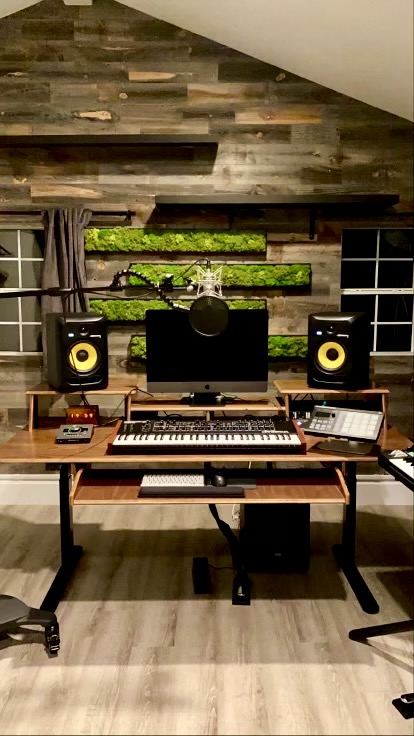
Four of our Skinny Panels are in the music studio of musical artist Galamatias, a Danish national, like our founder, Morten Klinte. Galamatias now resides in Los Angeles, California. (Photo provided with permission from Galamatias).
Both types of green walls are wonderful means by which to introduce nature into a workspace, residential space, co-working or event space, or spa/healthcare space. When we compare interior design practices with the first edition of this article (back in 2017) to today, we note that biophilic design and incorporating nature have become a “given” for many interior designers.
In fact, when Fast Company asked five of the world’s top designers to imagine the workplace of the future, mentions of nature, the climate, climate change, and our relationship to the natural world were mentioned by every respondent.
Living Architecture Monitor similarly addressed the need for nature in their piece titled, “Cooped Up Indoors? There’s A Reason You Don’t Feel Well.” The title does say it all but what you’ll find when you dive in is that biophilic design is being embraced by hospitals, senior living centers, spas, and rehabilitation facilities.
“A recent study by researchers at the Harvard T.H. Chan School of Public Health, published in the journal Environment International, supported that claim, concluding that biophilic interiors helped inhabitants recover from stress and reduce anxiety more quickly than interiors without natural elements, and documented a notable reduction in blood pressure.”
Thus, the need for the attention restoration that real nature provides. We have seen, in recent years and even more so throughout the global pandemic that many of us are looking to greenery and nature as a counter-balance to technology, to heal our minds, and to provide a sense of well-being. In fact, we can quantify both the most impactful elements on productivity along with the impact of productivity on the business bottom line. For that, we turn to Kelai Diebel’s article for Makers of Sustainable Places titled 3 Main Ways Biophilia Revolutionizes Business. You will find data. links and visuals that explain the positive effect of biophilia on the business bottom line.
What’s a Living Wall and What Kind of Maintenance Does it Need?
So here’s the deal–living walls often referred to as green walls, are comprised of real, living plants that require soil or substrate and water usually provided through an integrated water delivery system. Living walls are stunningly gorgeous and there are now more companies offering living walls and living wall systems than there have ever been heretofore.
For detail on how the living wall is constructed, we refer you to Ambius. They break down the details of how the living wall is constructed as well as the history of the living wall and a video on their site and it is very much worth the read (and view).
One thing to keep in mind as you examine this option is weight and Growing Green Guide out of Australia provides a great table of information on the weight of various plants for rooftops as well as vertical living walls. Based on the research we have conducted on the companies that provide living walls, the average weight of a living wall is 10 to 12 lbs. per square foot and you can check out LiveWall’s site for additional FAQs on their specific system functions and benefits.
We have also been keeping our eye on Urban Strong and they’ve got a killer article on how living walls can make you smarter, along with making you feel better and happier in public and workspaces.
We discovered Eco Brooklyn Living Walls because of their gorgeous Instagram feed and we recommend a visit to their site that provides ample information on their systems, their process, and what they have learned over the years as they “green” New York.
NaturaHQ has sprouted in the state of Texas and has expanded its footprint to include offices in Austin, Corpus Christi, Houston, and San Antonio in addition to the Dallas location.
One of our favorite living walls (and one of the first of its scale) is in Canada at the University of Ottawa. The living wall in the Faculty of Social Science building is the tallest living biofilter in North America. The green wall is one example of the University’s sustainability projects.
We also did some research in Denver, Colorado, and noted that there are some “lighter” versions of living walls there that involve shelves of single, potted plants that when combined, look really gorgeous. The living wall of phylodendrons at Let Em Have It Salon is stunning. Owner Fallene Wells and her team are really lovely people and Fallene recently turned her enterprise into a B Corporation (Congrats on that important endeavor Fallene). Fallene told me she has a service that comes to maintain the plants on a regular/weekly schedule to ensure it stays healthy and green.
As you would expect, living walls require water and attention which is why folks still look at us incredulously when we tell them our moss walls are maintenance-free.
However, if you have a green thumb and would like to create your own living plant wall indoors, we refer you to Fantastic Services and their article titled, “How Do You Build an Indoor Living Wall.” The article is a step-by-step guide with plant recommendations, tools you will need, and maintenance tips.
What is a Moss Wall and What Kind of Maintenance Does it Need?
We construct our green walls aka moss walls with real, but dormant moss that does not require any dirt, soil, or substrate, and does not require any watering or misting of any kind.
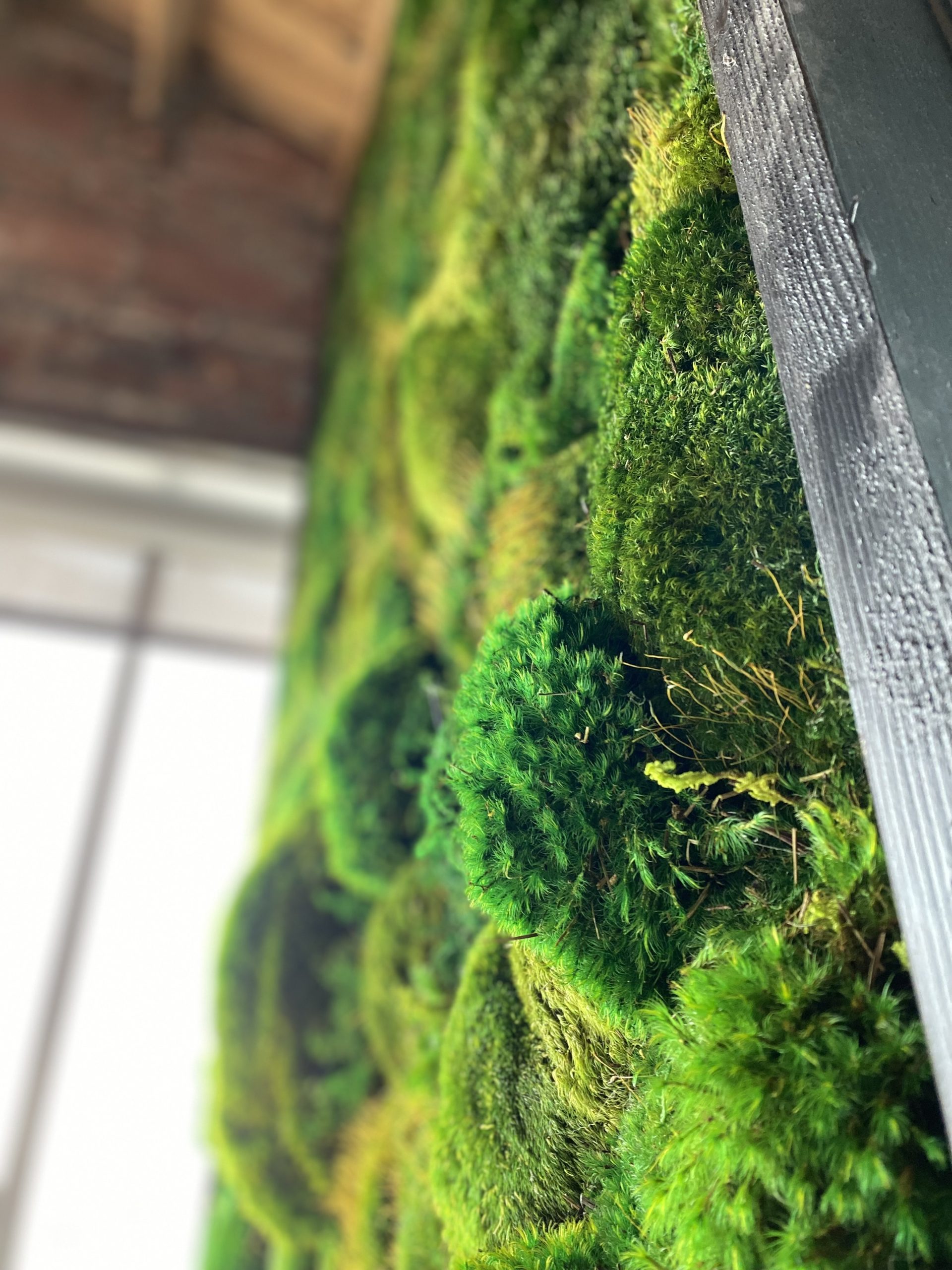
Floor-to-ceiling pillow moss wall by The Fat Plant Society for The Laya Center, a Wellness Center with state-of-the-art wellness offerings.
We explain it like this: a moss wall is neither living nor dead, it is made of moss that is dormant, having been rendered dormant using a natural paraffin or glycerin process.
Moss walls retain their lush look with zero maintenance (except for the occasional dusting using compressed air just as you would use on a computer keyboard) for at least ten years and we’re developing and testing a natural spray that will extend the life of a moss wall indefinitely.
The Fat Plant Society moss is harvested in North Carolina and Kentucky and when it arrives, it smells just like standing in the middle of a forest. The moss has acorns and other treasures from its birthplace and we clean the moss before laying it out in our design studio. From there we use the moss just like a painter would use paint to achieve the colors, textures, and depth of each, handmade panel or piece.
We use a few different kinds of moss to achieve the desired look and the moss we use depends on what the client is seeking in terms of the “feel” of their moss wall or frame. The photos above and below are pillow moss and at times, we use sheet moss as a base (to enhance soundproofing and noise reduction) and even layer the different types on top of each other or next to each other so as to provide the most biophilic look possible.
Our designs tend toward the natural and we like our designs to utilize clean lines and adhere to nature itself as much as possible so as to be timeless architectural elements.
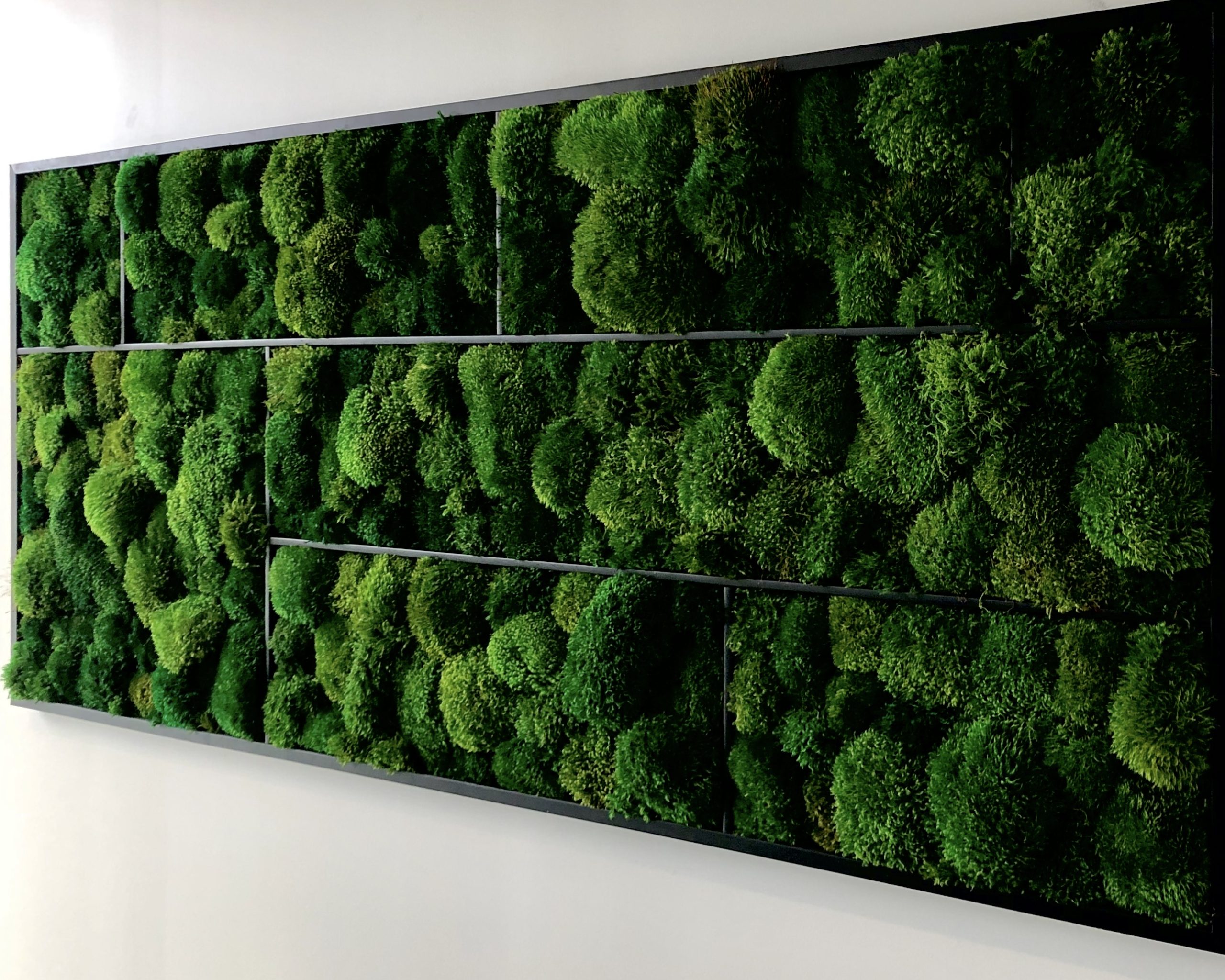
Pillow Moss in Planterbox design for Isom Collective for Avenue 82, the new home of BRR Architecture.
Pillow moss is replete with soft yellow hairs and varying shades of green as you can see in the photo below but changes, depending on the time of day and the light source as evidenced in the photo above.
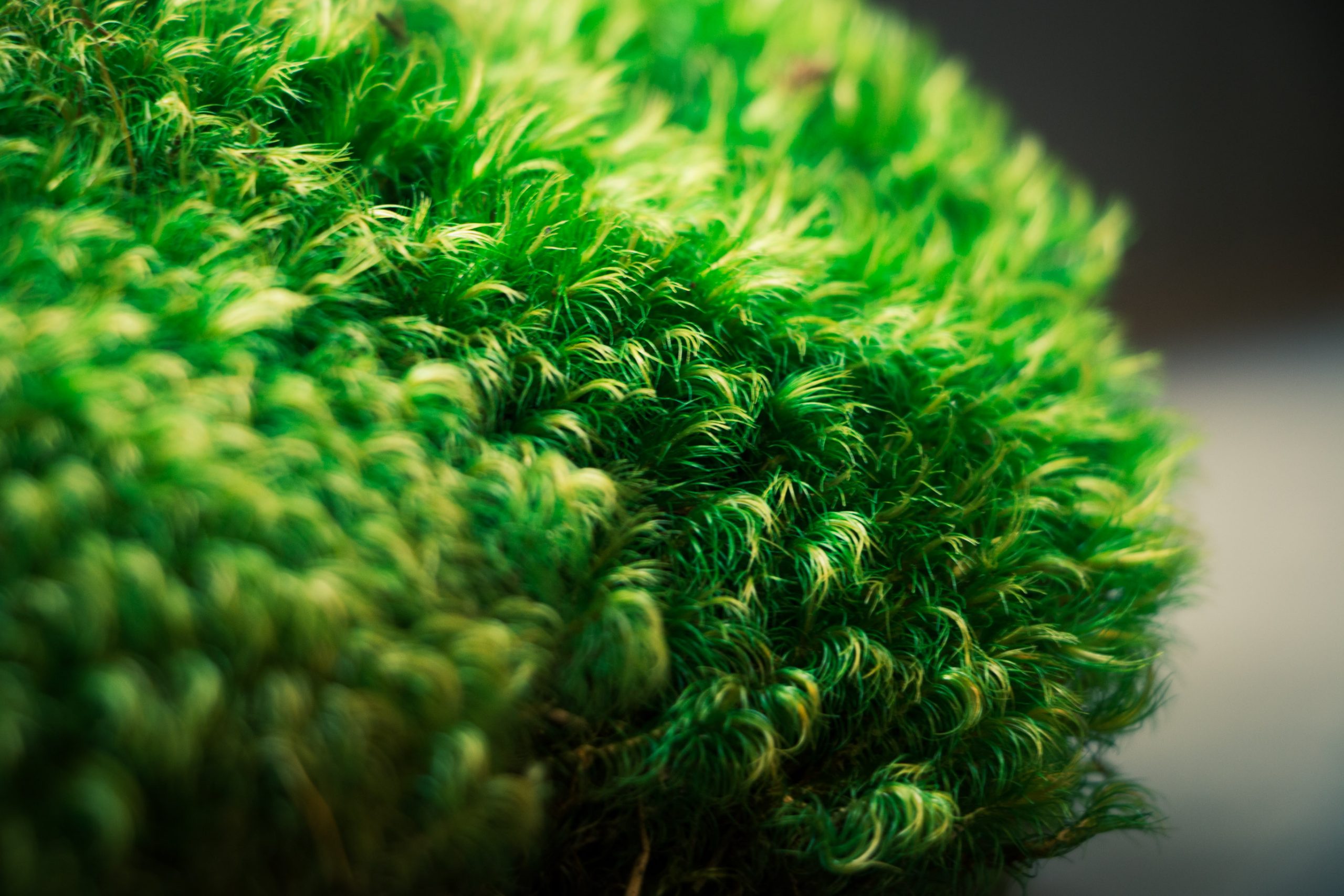
This close-up of a lone moss pillow features the little yellow hairs. Other pillows may have red hairs as well and each pillow is unique. Photo by Kyle Gammon at PeaceOneLovePhoto.
Contrast that look with the bright green of our reindeer moss with a pin-mounted black acrylic logo and you can imagine how exciting it is for us to select the type of moss that will bring the client’s vision to life (so to speak).
From logos to walls to groupings of circular or square frames, moss draws people in and they cannot resist touching it. The good news is, you are more than welcome to touch it as our American-grown and harvested moss (we find is heartier and comes in larger pieces than the mosses of Europe and the U.K.) is sturdy and soft to the touch.
How are Living Walls and Moss Walls the same?
Living walls and moss walls are the same in that they are both referred to as green walls and that is accurate on both counts. They are also the same in that both provide environmental benefits such as reduction of noise pollution and air pollution (moss walls absorb VOCs) but don’t just take our word for it, there are a number of articles that support the fact that moss, though dormant, is still providing many of the same benefits that living walls provide. In fact, since moss is so porous, it absorbs VOCs extremely well and dampens sound (particularly medium to high voice frequencies) better than plants like philodendron and the infamous snake plant.
Additionally, for our North American clients for whom sustainability is at the top of the list of design goals, The Fat Plant Society moss does not require overseas shipping and our real moss does not require watering or misting making it pretty darn sustainable.
Moss walls differ from living walls in that they do not need soil, watering or misting of any kind and the weight of a moss wall is less than 3 lbs per square foot in comparison to the 10-12 lbs per square foot weight of a living wall. They are also different in the sense that the living wall is literally that, living and needs care and attention on a weekly, if not daily basis.
Real moss, on the other hand, requires little to no maintenance at all. Last, but certainly not least, moss walls run roughly 40% less in installation costs than living walls and with zero maintenance (we do offer repair kits for when accidents happen).

26-foot tall pillow moss wall at Navitas.us and Smith & Boucher Engineering
Which one is best for your needs depends largely on how much maintenance you want to (and have the budget to) provide to keep your green wall looking lush.
Living walls run roughly $1,000 per month in maintenance depending on the size of the wall but you can expect to spend at least $3-$4K annually (at minimum) on maintenance for living plants at an impactful scale. Some living walls require an internal watering system which can give architects and contractors pause but if done well, the internal watering systems can save a great deal of time on maintenance.
Moss walls, on the other hand, are a one-time development and installation cost with little to no maintenance costs associated. For more information and specs on The Fat Plant Society moss walls and designs, we invite you to download our spec sheet that provides detail on our moss and installation process.
Both living walls and moss walls have incredible visual appeal and provide numerous health benefits and frankly, we’re in love with both but have chosen moss as our material of choice at The Fat Plant Society.
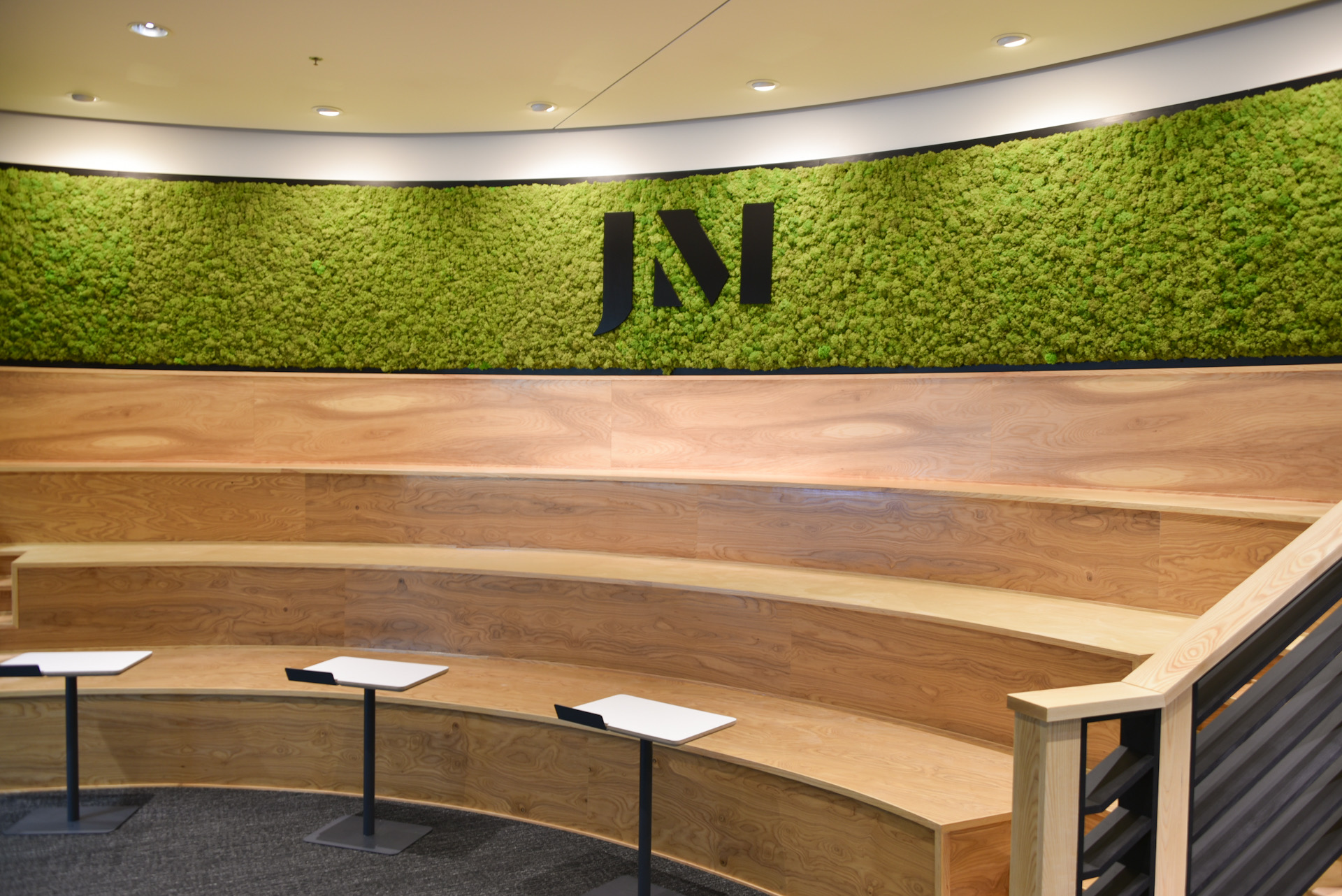
Curved Moss Wall for The John A. Marshall Company by The Fat Plant Society
So that’s the skinny folks. We can guarantee that bringing green into your workplace and living space has enormous benefits.
We are happy to answer any and all questions and walk you through our process and learn more about the project you are planning. We love all design-build projects and building to spec is what we do.
As always, yours in the love of all things green,
Kasey & Morten

